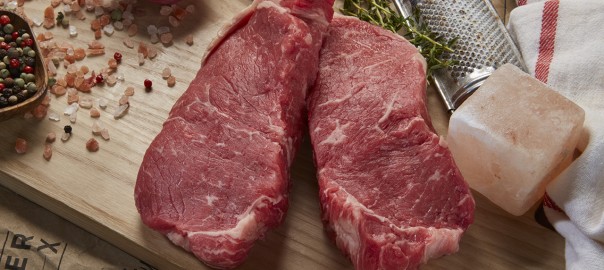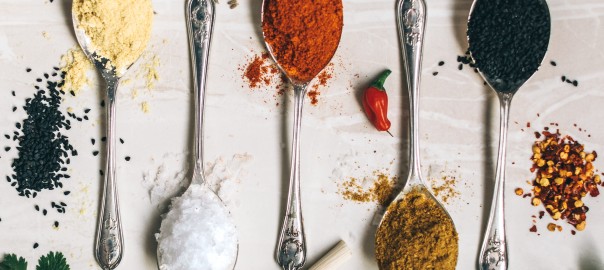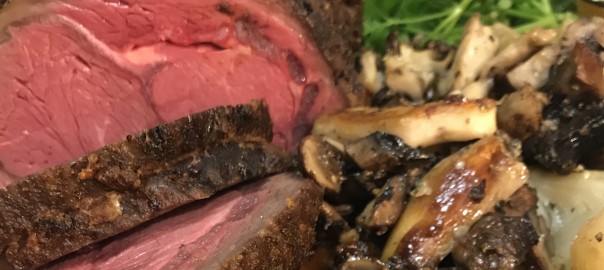Chef Yankel and the ButcherBox Kitchen are excited to share not only the best, easiest way to quickly cook a New York strip steak, but a way to get a perfectly tender NY strip from frozen.
TRANSCRIPT:
Hey there, I’m Yankel. And today I’m going to show you how to make the absolute. Perfect, New York strip steak. Plus five ingredients and you’re going to get a beautiful pan sauce out of it. Now. We’re doing it from Frozen. So let’s check out our steak in the freezer. Well, there is a beautiful New York strip rock-solid.
We’re going to head over to the sink. And what we’re going to do is just defrost the surface of it while we do some of our prep.
I’m going right into the sink in a bowl. I want it submerged in cool running water. So we’re going to fill it up. Now, I know I said from frozen. You’re probably wondering what’s he doing? It? Looks like he’s defrosting it. All I want is the surface defrosted enough for it to hold some salt and pepper.
That’ll take a few minutes while we let the water trickle. We’re going to head over to the counter and we’re going to slice up some of our ingredients we get everything ready in advance. I have to make more flavors maybe even complete dishes. So since we’re doing a New York strip steak in a cast-iron pan, I thought why not add a couple of other ingredients to make it extra delicious.
So we’re going to do some mushrooms. Just a nice little handful, and all I’m going to quarter them. And then we’re going to do a quickly sliced onion, and at the very end right before we go into the oven with our steak, we’re going to add a splash of balsamic vinegar and that’s going to give us a little bit of a pan sauce because we’re going to actually baste the steak with butter and garlic. All that’s going to come together plus the juices from the mushrooms, and that’s really what I want to capitalize on here.
They give off a nice amount of liquid, I want to turn that into something magical. So I got my onion, I’m just gonna take the ends off. And I think we’re just going to go with half an onion for this recipe. I can use the other half for whatever my next project is. Quick tip about slicing onions, onion has rings that go in a certain direction. I just want thin slices. So I’m going to let the onion and the shape of the onion do most of the work for me and just cut against those rings.
I’m going to use the garlic when I baste the steak, so I don’t want to mince it too much. I’m just going to go with semi-thin slices that way it won’t burn when it’s in that hot pan. Oh, goodness. It’s either nostalgia. or onions and garlic. It’s generally my excuse. All right, I think our steak has enough surface texture to absorb some seasoning.
So I’m going to go grab it and then we’re gonna get started. But before I leave, I’m going to preheat my pan. We’re going to go with medium-high heat because I want a good sear without burning. I’ve already got the oven preheated to 350°F. Now, before we get started one of the key points to getting a good sear on a steak is having a dry surface.
So what we’re going to do is open our package. I like to have a paring knife go right in on the edge. Great. All right. We want to dry every bit of moisture on that surface because any moisture is going to steam and steam is going to slow down the searing process. So I’ve got some paper towels ready, and I’m just going to blot all that moisture out.
Dry surface. And you can see just enough give for it to hold salt and pepper. I’m going to set that down there, and we’re going to season it. Now when it comes to salt and pepper, not all salts are equal. I like to use coarse kosher salt that gives me a nice texture to work with and kosher salt really melts beautifully on the meat as it cooks. So it gives it really good seasoning.
Then, of course, fresh cracked black pepper has the best flavor. A good pepper mill will get you everywhere. We’re gonna flip that over. A nice coating. remember we’re only seasoning the outside of the meat so we want to make sure it has a nice even cover, that way every bite is flavorful.
Alright, our pan is hot. We’re going to go into the pan with some high-temperature oil. I’ve got avocado oil here, and it can cook at very high temperatures without smoking and it’s refined and what that means is that it has most of the impurities taken out of it.
If you’re using an extra virgin olive oil, you risk the impurity scorching and you get that burnt flavor. So a good high temp oil will go a long way. Lots of alternatives out there, coconut oil, peanut oil, some of the sunflower, safflower, and canola oils work well. It’s up to you.
As soon as we have a little smoke, which we should have it almost immediately because the pan has been preheating.
That’s ready to go. So we’re going to go with our steak right into the pan.
Now, the key here is good contact with the pan. We want every inch of that steak touching the pan because when we brown steak when we brown meat, that’s where the flavor happens. It’s called the Maillard reaction, and we are building flavor compounds. So don’t skip the browning step. Good surface contact. I press down a little bit.
Resist the temptation to move that steak around. The first two minutes are crucial for a good sear. Once we move it, we’re going to lose that contact. So we’re just going to let it sit there for two minutes and build up that crust.
We’re about ready to flip it over and you know the New York strip has that very distinctive line of fat along one side. So what I like to do is before I flip it. I’m actually going to turn it on its side and make sure that that fat has good contact with the pan. It’s absolutely delicious. But it needs a sear.
So we’re just going to press it in there. Every inch of it, make sure it has a nice brown crust building and then we will flip the steak over and do the other side. That’s kind of what we’re looking for crispy fat. All right, we’re going to flip it over. There you go.
We’re gonna cook it for about a minute on this side and then we’re going to add butter and garlic and we’re going to baste it. Butter and garlic together is a magical combination, but butter has this characteristic of transferring flavor. So we’re really going to let the steak absorb that garlic flavor and basting it when you’re about three minutes into cooking is a perfect time for it to absorb all that garlicky goodness.
Now what I’m going to do is move the steak to the top of the pan and get my butter foaming. And as soon as I see big bubbles from the butter, it’s time to start giving that’s steak a bath.
Always give your steak a nice bath.
I’m a butter and garlic lover. And so I bathe my steaks in it. Perfect.
All right, we’re going to pull the steak out for just a minute and we’re going to saute our onions and mushrooms before putting our steak back in and putting everything into the oven.
Set that down right there onions go in, mushrooms go in.
Don’t need to cook it for long on the stovetop. We’re just going to stir it up and make sure it has every bit of coating that we for need maximum flavor. Now, we’re going to add a splash of balsamic.
We’re going to put our steak right back on top. We’re going to go into our preheated oven for about ten minutes; but we’re going to check it in three minutes, so we know exactly what temperature it is so we can track it better. Remember grass-fed beef can cook a little bit faster than normal. So pay attention.
A few minutes into cooking. I want to temp the steak. I like to gauge where it’s at and that will help me decide how much longer it’s going to need exactly. So we’re looking at okay 90 degrees to me that means five or six more minutes. The temperature tends to rise much more quickly. Once it passes a 100°F.
I think we’re just about there. So we’re going to give it one more temp.
That’s perfect. We’re looking for 115°F and rising, under 120°F, and I’ll tell you why.
Meat does this thing where it continues to cook even after you’ve taken it off the heat. It will rise at least 5°F and maybe even 10°F depending on how hot it is and how much time we let it rest. So, it’s going to finish cooking and I’m going to move it to the cutting board, so it doesn’t have any more heat hitting it.
We’re going to leave it there eight minutes in that time. It will rise to at least 5°F. It’s, in fact, getting hot or not colder. If we want to keep the surface hot as well, we’ll loosely tent it with foil, just so it can breathe a little bit. In the meantime, we can reduce a little bit of that liquid for our sauce.
It’s going to cook down real fast. It’s going to be absolutely delicious all those flavors come together. The mushrooms just give off all the liquid we needed for a sauce. The butter, the balsamic, the onions also give off a lot of moisture. So all together, we’re just taking all that liquid and turn it into something absolutely magical.
And of course, I never miss an opportunity to add a little bit more seasoning. So I’m just going to get a little bit salt and one quick grind of fresh ground black pepper. As the moisture burns off you’re going to see the bubbles in the pan begin to get larger. As they get larger, the sauce is actually going to come together.
And that’s when we’ll know it’s done. So right now, we have little bubbles. Bigger bubbles mean we’re exactly where we want it to be.
Smells so good.
Beautiful. Well, we’re going to let that steak rest for a few minutes. We’re gonna let the pan simmer. Let’s just give it low flame. All right our steak has rested long enough. We’re gonna slice into it.
Now when it comes to New York strip, there are two things to take into consideration. One is that beautiful strip of fat, which I love to eat, but I’m going to take off in order to slice. So we’re just going to slice that strip of fat right off and set it aside. Gorgeous. You can already see that steak is perfectly cooked.
Now, we’re going to slice it right down the middle. Like so. And then we’re going to slice it against the grain because it’s going to be crazy tender when we do that. It’s already a super tender steak. Slicing against the grain makes it even more tender.
Yeah, it doesn’t get any better than that. From frozen. Perfect. Medium-rare. Super juicy. That’s good stuff. Well, it looks like it rested the perfect amount of time. You can always tell from how much moisture is left on the board. Not much in this case, which means every bite we get is going to be crazy juicy.
So I’m going to put that right onto my plate, and then we’re going to top it off with our mushrooms, onions, and balsamic.
And now we have these beautiful roasted mushrooms and onions, packed with flavor. Absolutely gorgeous. We’re going to go right on top. It doesn’t take time, generally uses ingredients you have sitting around the house. Put it all into a pan together. Sear it. Baste it. Throw it in the oven. Rest it. Eat it.
That’s the whole process. It’s so easy. I ‘m Yankel, go cook something from frozen.






